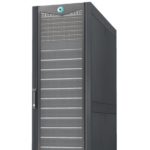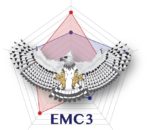A novel program at Stanford is finding a second life for used HPC clusters, providing much-needed computational resources for research while giving undergraduate students a chance to learn valuable career skills. To learn more, we caught up with Dellarontay Readus from the Stanford High Performance Computing Center (HPCC).
Argonne to Deploy Cray ClusterStor E1000 Storage System for Exascale
Today HPE announced that ALCF will deploy the new Cray ClusterStor E1000 as its parallel storage solution. The new collaboration supports ALCF’s scientific research in areas such as earthquake seismic activity, aerospace turbulence and shock-waves, physical genomics and more. “Our recent introduction of the Cray ClusterStor E1000 is delivering ALCF unmatched scalability and performance to meet next-generation HPC storage needs to support emerging, data-intensive workloads.”
LANL’s EMC3 Consortium enjoys rapid growth in its first year
Just over a year after Los Alamos National Laboratory launched the Efficient Mission Centric Computing Consortium (EMC3), 15 companies, universities and federal organizations are now working together to explore new ways to make extreme-scale computers more efficient. “In the first year of EMC3 we have already seen efficiency improvements to HPC in a number of areas, including the world’s first NVMe-based hardware-accelerated compressed parallel filesystem, in-situ analysis enabled on network adapters for a real simulation code, identifying issues with file system metadata performance in the Linux Kernel, record-setting in situ simulation output indexing, demonstrating file-system metadata indexing, and more.”
Time-lapse Video of Big Red 200 Cray Supercomputer at Indiana University
In this video, technicians install the Big Red 200 supercomputer at Indiana University. IU is the first university to deploy a Cray Shasta system, the Cray Slingshot interconnect and Cray Urika AI Suite for Shasta, providing its engineers, researchers and scientists powerful resources for the next era of computing. The new supercomputer will be instrumental in the University’s exploration and advancement of AI in education, cybersecurity, medicine, environmental science and more.
Full Roundup: SC19 Booth Tour Videos from insideHPC
Now that SC19 is behind us, it’s time to gather our booth tour videos in one place. Throughout the course of the show, insideHPC talked to dozens of HPC innovators showcasing the very latest in hardware, software, and cooling technologies.
Theta and the Future of Accelerator Programming at Argonne
Scott Parker from Argonne gave this talk at ATPESC 2019. “Designed in collaboration with Intel and Cray, Theta is a 6.92-petaflops (Linpack) supercomputer based on the second-generation Intel Xeon Phi processor and Cray’s high-performance computing software stack. Capable of nearly 10 quadrillion calculations per second, Theta enables researchers to break new ground in scientific investigations that range from modeling the inner workings of the brain to developing new materials for renewable energy applications.”
AMD Readies EPYC for Exascale with ROCm at SC19
In this video from SC19, Derek Bouius from AMD describes how the company’s new EPYC processors and Radeon GPUs can speed HPC and Ai applications. With its EPYC processors, Radeon Instinct accelerators, Infinity Fabric technologies, and ROCm open software, AMD is building an Exascale ecosystem for heterogeneous compute. “Community support for the pre-exascale software ecosystem continues to grow. This ecosystem is built on ROCm, the foundational open source components for GPU compute provided by AMD.”
Fujitsu A64FX Arm Processors come to Cray CS Supercomputers
In this video from SC19, Takeshi Horie from Fujitsu and Steve Scott from Cray describe how the powerful Arm-based A64fx Arm Processor will power the next generation of Cray CS Supercomputers. “We are delivering the development-to-deployment experience customers have come to expect from Cray, including exploratory development to the Cray Programming Environment (CPE) for Arm processors to optimize performance and scalability with additional support for Scalable Vector Extensions and high bandwidth memory.”
CFD Leader NUMECA adopts Advania Data Centers for HPC-as-a-Service
Today Advania Data Centers (ADC) announced a strategic HPC service partnership with NUMECA International, a market leader in computational fluid dynamics CFD, multiphysics and optimization. “This HPCaaS partnership allows NUMECA to concentrate on its core software developments and support activities while ADC handles its HPC cluster management, power and cooling — ensuring peak performance at all times based on their Intel Xeon Scalable processor-based infrastructure.”
AMD Delivers Best-in-Class HPC Performance at SC19
Today at SC19, AMD announced a set of new customer wins and new platforms supporting AMD EPYC processors and Radeon Instinct accelerators, as well as the release of ROCm 3.0 development environment. “HPC organizations are continuing to adopt the 2nd Gen AMD EPYC processor and Radeon Instinct accelerators for more powerful and efficient supercomputing systems. The 2nd Gen EPYC processors provide twice the manufacturing application performance and up to 60% faster Life Sciences simulations than competing solutions, while the Radeon Instinct GPU accelerator provides up to 6.6 peak theoretical TFLOPS Double Precision performance for HPC workloads.”













